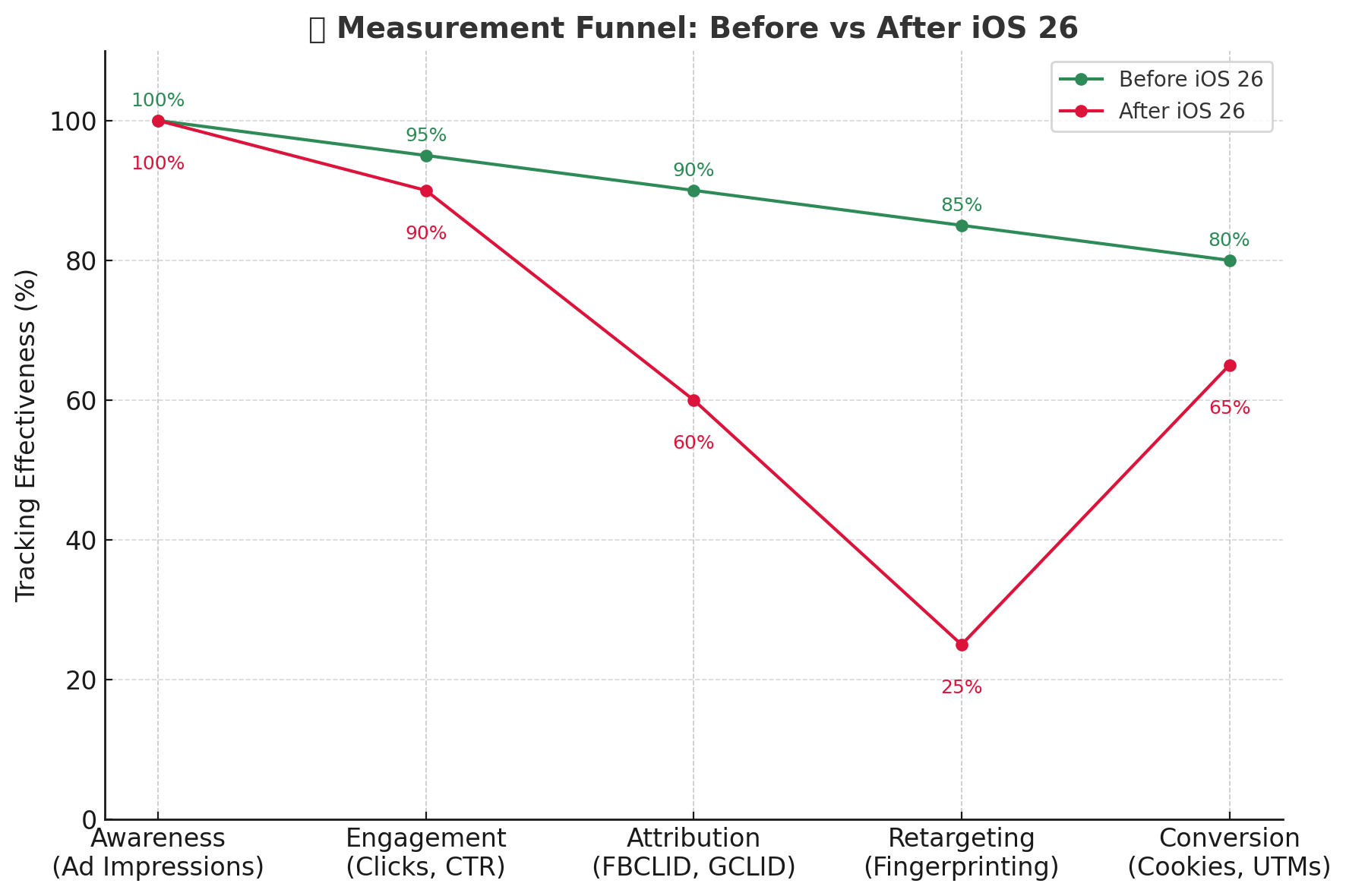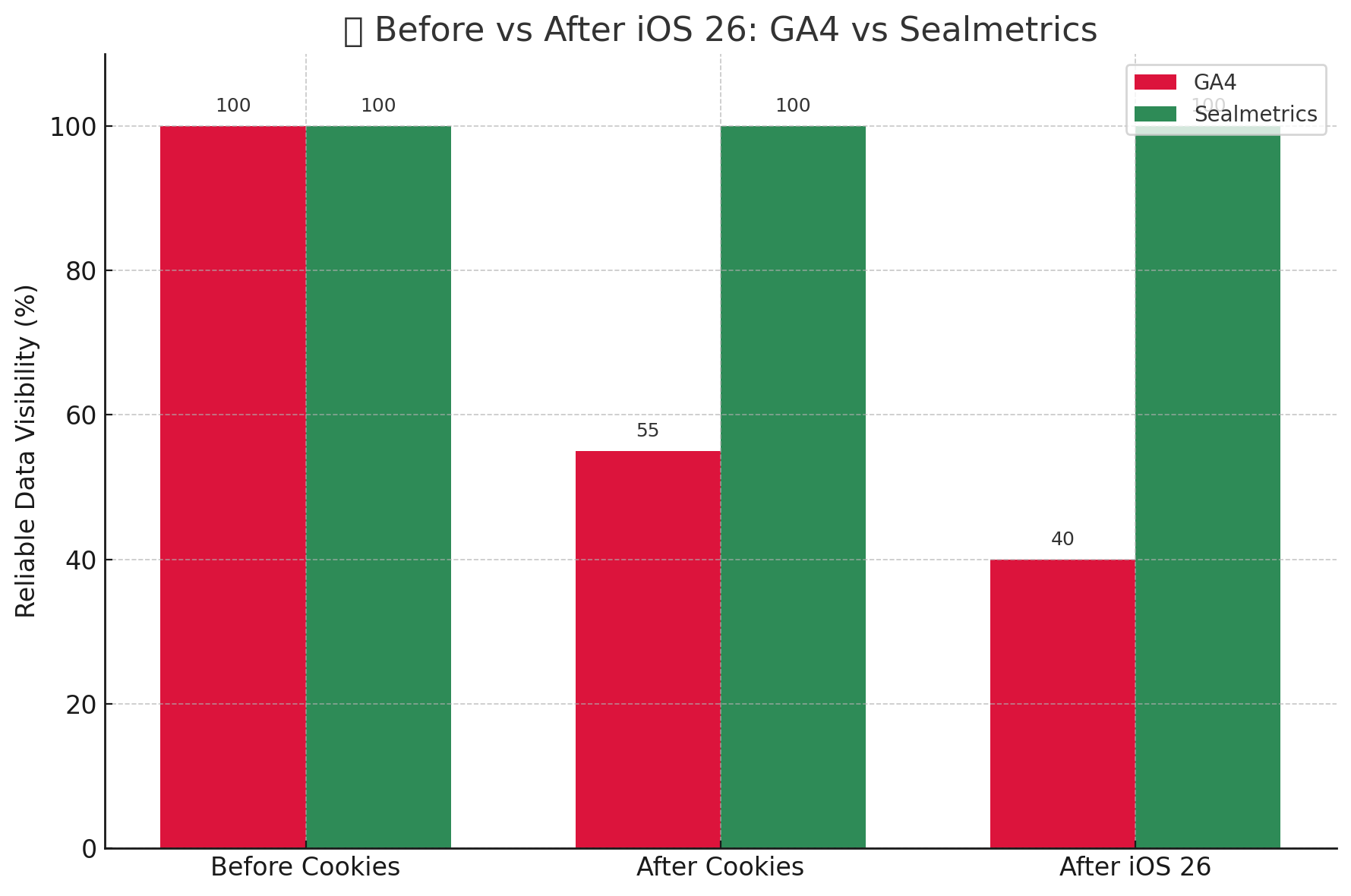Safari + iOS26: What Marketers Need to Know About Tracking and Attribution

Apple has just released iOS26, and with it Safari introduces major privacy-first restrictions. For marketers, agencies, and ecommerce managers, this update raises an urgent question:
👉 How can you measure conversions in Google Ads if gclid, fbclid, and other IDs are removed from the URL?
In this guide, we’ll explain what iOS26 changes, how it impacts tracking and attribution, and what solutions exist for marketers who need complete, reliable, and compliant data.
🚨 What’s new in Safari with iOS26?
Starting with iOS26, Safari:
- Removes tracking parameters → gclid, fbclid, and other ad identifiers disappear.
- Blocks fingerprinting techniques → canvas, audio, WebGL, font, and screen-based methods drop from 90%+ effectiveness to only 15–25%.
- Weakens ad platform attribution → Google Ads and Meta algorithms receive fewer signals, making campaign optimization slower and more expensive.
📉 Why does this matter for Google Ads attribution?
Attribution in Google Ads depends heavily on URL parameters and identifiers like gclid. With iOS26:
- Safari users (20–40% of traffic in many ecommerce businesses) become invisible.
- Google Ads’ conversion modeling becomes less reliable.
- Campaigns enter longer “learning phases” because algorithms lack feedback.
- Marketers may end up making budget decisions with only 30–40% of real visibility.
⚠️ Remember: iOS + Safari users generate a 2.3x higher ARPU than Android users. Losing visibility here means losing sight of your most valuable customers.
⚡ What about UTMs, wbraid, and gbraid?
- UTMs: Still work for now, since they track traffic at an aggregate level and don’t identify individuals. But Apple already flagged them as “under watch.”
- wbraid and gbraid: Google Ads uses them as replacements for gclid. They function in a similar way, so it’s very likely Apple will block them next.
➡️ Once Apple blocks these, every identifier in the URL that can link back to a user disappears — and Google will no longer be able to reliably assign conversions.
🔄 Before vs After iOS26 (Comparison Table)

✅ The solution: Consentless Analytics with Sealmetrics
Sealmetrics was built for this exact moment.
Unlike GA4 or ad platform tracking, Sealmetrics does not depend on cookies, IDs, or fingerprinting. Instead, it delivers:
- 100% of conversions measured, even in Safari.
- GDPR-compliant architecture, legal in Europe and beyond.
- Reliable attribution for Google Ads, Meta Ads, and more.
- A single source of truth for CMOs and CFOs who need to trust their data.
With Sealmetrics, you can still know your real ROAS, even when gclids, braids, and fingerprints are gone.
❓ FAQ: iOS26 and Google Ads Attribution
1. Will Google Ads still work after iOS26?
Yes, campaigns still run, but attribution is less reliable. Algorithms take longer to optimize because they receive less conversion feedback.
2. Are UTMs blocked by iOS26?
Not yet. UTMs still work for aggregate campaign tracking. But they could be restricted in the future.
3. Can wbraid and gbraid replace gclid?
For now, yes. But Apple may block them as well, since they function similarly to gclid.
4. What’s the alternative to cookies and IDs?
Consentless analytics, like Sealmetrics, measure conversions without fragile identifiers, ensuring you keep full visibility.
5. How does this affect ecommerce specifically?
Ecommerce brands often see 40%+ of sales from iOS + Safari users. With iOS26, losing visibility here means losing clarity on your most profitable customers.
📥 Download the full guide
We’ve prepared a full interactive guide:
👉 “Safari + iOS26: The New Era of Web Analytics”
Inside you’ll find:
- The global economic impact of iOS26.
- Which methods are already broken.
- Practical steps to adapt and keep 100% of your data.
💬 [Download the full guide here]
Final thoughts
Apple’s iOS26 is a turning point. It doesn’t mean the end of marketing, but it does mean the end of outdated tracking models.
Marketers who adapt now will lead in a privacy-first world.
And with Sealmetrics, you can measure with clarity, compliance, and confidence.
